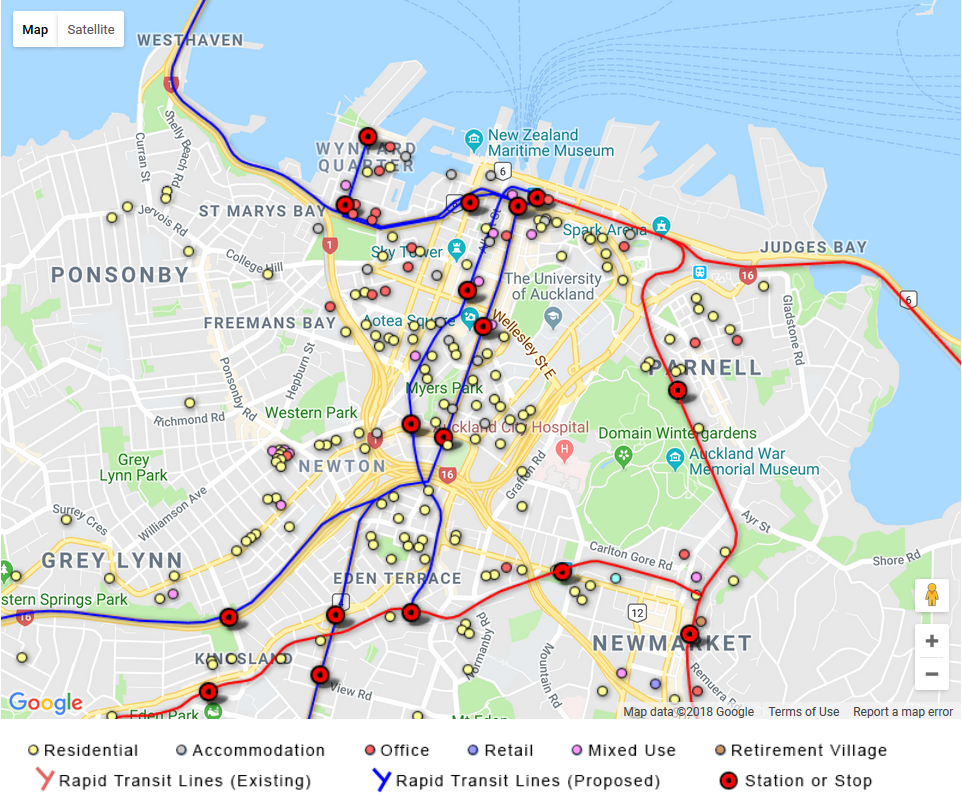Here on Greater Auckland, we’ve got the sponsored RCG Development Tracker page which shows hundreds of housing projects across Auckland (and NZ): apartments, terraces, retirement villages etc. It also shows big commercial developments and Auckland’s rapid transit network.
After a great post from Matt the other week, I’ve updated the Development Tracker with the proposed light rail lines along Dominion Rd and out to the airport, and out to the North West. I’ve also switched up the colours: all existing rapid transit is now shown as red lines, and all proposed rapid transit is blue. Here’s Central Auckland:
The updated map is handy for showing where the light rail lines will go. I think it’s pretty exciting – try flicking to satellite view (in the top left corner) and take a look along the Dominion Rd route, which brings in many of Auckland’s town centres and will serve many thousands of people. Imagine how many more yellow dots there will be along those blue lines in the next few years!
Another key focus of these posts is looking at how many homes are being built in Auckland (and elsewhere). New Zealand lacks consistent data on home building – the best we have is “building consents”, which give a good indication of how many homes will be built in the next year or two.
It’s good news this month: the number of homes consented in Auckland keeps ticking up, and reached 11,629 for the year to April 2018. We need more than this, but it’s high compared with what has been achieved in the past. This is the third-highest number of consents in the last 28 years, with only 2003 and 2004 higher.

Looking across the rest of New Zealand, home building is at high levels pretty much everywhere. Hamilton and Tauranga, which are also fast-growing cities, have plateaued. Proportionately, they’re building faster (and probably growing faster) than Auckland. Christchurch keeps easing back from the post-quake boom, but is still high compared with historical levels.



 Processing...
Processing...
Thanks John. Always an interesting read.
Looking at the present and future RTN map through the cbd makes me ask, why isn’t a busway along SH1 part of the CFN2? In South Auckland it would make a lot of sense, being 2 km or so from the parallel train line, and through the cbd it provides a route that is SE to NW.
Just could provide extra capacity N-S that doesn’t cost $500m and would have the advantage, with road reallocation, of increasing people-flow while reducing cars into the cbd…
Sure is a lot of crain activity around the city showing the reality of these developments.
*crane, thought that looked weird
Some interesting stats in this article “Smaller dwellings could see cheaper housing for Auckland” from today’s NZ Herald https://www.nzherald.co.nz/nz/news/article.cfm?c_id=1&objectid=12066058
The number of new Auckland homes approved rose from 3282 in the 12 months to April 2011 to 11,629 in the 12 months to April this year.
Stand-alone houses accounted for 82 per cent of new dwelling consents, apartments were 5 per cent, townhouses and home units 8 per cent and retirements village units 5 per cent in 2011.
But in the year to April, stand-alone houses accounted for just 48 per cent of new dwellings, apartments 22 per cent, townhouses and units 22 per cent and retirement village units 8 per cent.
This is really interesting. So when developers on national radio talk about a slow down how does that fit in?
A good way to think of it is probably of there being a “pipeline” of development, with various stages in that pipeline that could potentially be bottlenecks. This could include: land supply and prices, difficulty in getting consents, finance, construction costs, and final sale prices.
To me, it seems like the main bottleneck is construction costs – these have been rising rapidly in the last few years, and builders have become very busy and less interested in taking on new work. It’s kind of “all hands on deck” already.
Sale prices rose a lot over 2012-2016 say, but have been quite flat since then, or even gone back a bit.
So the “slowdown” for developers is driven by the smaller margin between what it costs them to build housing and what they can sell it for. It hasn’t shown up in the consent stats above, and it certainly hasn’t shown up in the amount of building underway. But it means that fewer new projects are being launched, and there will probably be fewer new projects beginning construction in the next little while.
And that’s not a bad thing, in my view. It’s like builders (and developers) need to focus on the projects they already have underway, for the next year or so. There’s been a huge hump of construction work that builders are still chipping away at. And by next year, there might hopefully be a bit more resource available so that some more new projects can start, and so on.
That’s my take on it; it’s often tempting to point the finger, and people always like to blame the council because the council can’t fight back. Finance is often highlighted as an issue at the moment too. But I think most of the issues stem from a lack of physical resource to get more things moving.